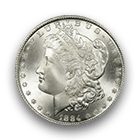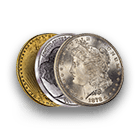Recently I read an article that mentioned the Trial of the Pyx and the importance that institution has held in England since 1248. What is the Trial of the Pyx you ask? I was curious too. Let’s delve a little further.
Similar to the United States Assay Commission, the Trial of the Pyx is a “judicial ceremony in the UK [United Kingdom] to ensure that newly minted coins from the Royal Mint conform to their required dimensional and fineness specifications.”
The U.S. Assay Commission was dissolved by President Jimmy Carter in 1980 to save $2,500, despite being the oldest operating federal commission. The very first U.S. Assay Commission meeting was held only a few days after George Washington ended his presidency. That being said, in 1980 the U.S. Mint was producing very few bullion-related items.
Interestingly, the Trial of the Pyx continues in the UK today, but the U.S. Assay Commission was not resurrected once the U.S. Mint started producing bullion related items again. Arguably, the product quality control at the U.S. Mint, as well as standard bullion planchet supplies, eliminate virtually any issues with weight or fineness in today’s U.S. Mint products.
The Importance of Accuracy of Information
Markets change, but the form, weight, and fineness of bullion and numismatic items is constant. These constants aren’t rocket science, but numbers are sometimes manipulated – especially when money is concerned.
The vast majority of individuals who have an interest in bullion or coins realize the value of that item is weight related. Confusion in weights, fineness, and indeed authenticity is often a function of lack of knowledge or obfuscation.
While we can inform ourselves with the knowledge needed, buying known authentic products like PCGS-graded coin and bullion coins is crucial to avoiding fraud. You need to know both what you are buying (or selling) and how the price reflects a premium and/or discount as compared to the melt value.
The metals markets are constantly moving – sometimes there are premiums or discounts. You should always remember whether avoiding a small premium on a PCGS-graded, premium bullion product is really worth the bargain price of an item you’re uncertain about.
Plated and “Filled”
Gold plated or filled items have no bullion value. Both of these types of gold jewelry contain only microns of real gold, which is why plated and/or filled jewelry is so cheap to begin with.
The miniscule amount of actual gold or silver contained in a gold- or silver-plated item is indeed miniscule. The purpose of this plating is obvious. The manufacturer wants to make a product that is attractive and “appears” to be valuable. Sure the plating makes the item more attractive, but the value is not enhanced. In most cases, plated items do not have any bullion value.
Most numismatists have some knowledge of the weight or actual gold content of many of our U.S. gold coins. Indeed, the weight and fineness are fundamental in the valuation of the metal itself as well as the currency value it represents.
Know The Math
I often harp on doing your homework prior to any transaction, but the fact of the matter is that virtually all bullion transactions are built around math. While we can’t control or predict the market itself, it is in your best interest to know both your product and the conversion factors that help determine its value.
Additionally, knowing the facts about your coins or bullion items will allow you to determine an estimate of the value of your bullion items at any given time using spot silver and gold prices readily available on a constant basis. You should always be able to determine what your bullion coin or item melts for using basic conversion ratios.
Let’s look at some very basic conversion data. Conversion data allows you to determine the gold or silver weight contained in your coin, bullion, or even scrap jewelry item (depending on karat weight). Bullion weights are expressed in troy weight. Some of those conversion numbers are listed below:
- 24 grains = one pennyweight
- 20 pennyweight = one ounce
- 240 pennyweight = 12 ounces = one troy pound
The actual gold percentage or gold karat weight usually expressed as 10K through 24K gold fineness are listed below:
- 10K = .417
- 12K = .500
- 14K = .583
- 16K = .667
- 22K = 917
- 24K = .999
Let’s look now at the most often-encountered U.S. coins that frequently trade as bullion items. For the most part, U.S. silver coins are referred to as 40% and 90%. Most U.S. dimes, quarters, and half dollars struck prior to 1965 are made of 90% silver. Kennedy Half Dollars minted from 1965 to 1970 were made with 40% silver. Note that there will always be a discount on this amount to cover any refining/trade costs, but the percentage of actual silver is .723 for 90% and .295 for 40% silver coinage.
Let’s use $30 per ounce silver as an illustration to determine the actual amount of silver in $1 face value of both U.S. 90% and 40% silver coins.
- 90% silver: $30 X .723 = $21.69
- 40% silver: $30 X .295 = $8.85
Of course, numismatically related coins are most often valued more than their melt value, but many common U.S. silver coins trade as a function of this ratio albeit at a discount to allow a profit for the dealer.
Authentic U.S. gold coins are relatively easy because their weight and fineness are known. In fact most U.S. gold coins are not melted, but rather held in their U.S. coin form because of their pedigree. Let’s look at the actual gold weight for the six classic U.S. gold denomination coins produced prior to 1933:
- $1 – .0483
- $2.50 – .1209
- $3 – .1451
- $5 – .2418
- $10 – .4837
- $20 – .9675
But for some exceptionally common $10 and $20 U.S. gold coins, most classic pre-1933 issues carry some numismatic premium in addition to their gold value expressed in percentage above. Currently, because of near-record high gold bullion prices, many common U.S. gold coins will trade at no premium whatsoever.
Knowing some basic bullion conversion facts and ratios are foundational to your numismatic knowledge. While most of us would like to focus on our favorite coin series, knowing the basic bullion value always gives you a place to start or basal value. Markets may change, but form, weight, and fineness do not. You need to know!







 Copper & Nickel
Copper & Nickel
 Silver Coins
Silver Coins
 Gold Coins
Gold Coins
 Commemoratives
Commemoratives
 Others
Others
 Bullion
Bullion
 World
World
 Coin Market
Coin Market
 Auctions
Auctions
 Coin Collecting
Coin Collecting
 PCGS News
PCGS News